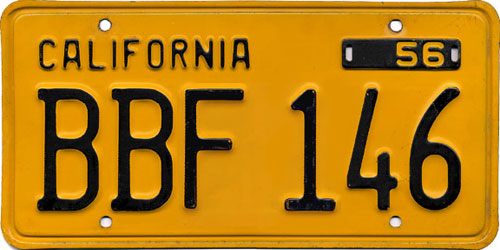
Prior to 1942, a new license plate was issued to every vehicle registered in California annually. World War II, however, meant that the metal from which to make the license plates became scarce. Starting in 1942, vehicles that already had a license plate were instead issued small metal overlays (called validation tabs) with only the last 2 digits of the year stamped onto them. These were shaped to match the portion of the plate where the last 2 digits of the original (issuing) year were shown; the recipient was supposed to place it directly over the old year. In 1944, metal became scarce enough that the first validation stickers were issued — a practice that would not be seen again until the standardized yellow plate era (1956-1962).
Nearly all of these plates were all made out of steel. However, during WW2 steel was in short supply and at some point California opted to instead make its plates out of aluminum for the first time. The practice reverted to using steel after the second world war ended, but was briefly resumed during the Korean war. (Source: VR-Manual-Appendix-1E-accessible-5-2022.pdf, retrieved from https://www.dmv.ca.gov/portal/file/vr-manual-appendix-1e on 27-June-2025)
New license plate designs appeared every few years thereafter, until an internationally standardized shape and size appeared in 1956. Presumably, since these 1945-1955 plate designs all had the year in a different place, an entire new plate had to be issued to a vehicle every time the plate designed changed. (Otherwise, the new validation tabs wouldn't properly cover up the old year.)

In 1956, the dimensions of the plates were changed to the modern 12 inches by 6 inches, to conform to a new nationwide standard. The 1956 plates had raised (embossed) black text on a yellow background. Rectangular holes on either side of the "56" were put there to allow metal validation tabs to be placed over the year. However, validation tabs were never issued. Instead, from 1957 through 1962, validation stickers with all 4 digits of the year written on them were to be placed next to the "56" on the plate.
From 1929 until 1956, passenger plates usually had license numbers consisting of a single numeric digit, followed by a single letter, followed by 4 more digits, arranged in three pairs of characters with spaces between them. Starting in 1956, this changed to 3 letters, followed by a space, followed by 3 digits, a pattern which carried forward into the black license plate era and beyond.
From 1929 onward, commercial plates had license numbers consisting of a single letter followed by 5 digits. This pattern continued forward into the black license plate era and beyond.
Prior to 1959, trailer plates had license numbers consisting of 6 digits, often with a small space between each group of 3 digits. In 1959, these combinations ran out. Because single-letter combinations were already in use for commercial plates, and 3-letter combinations were in use for passenger plates, they opted to switch to license number consisting of 2 letters followed by 4 digits.
Prior to 1951, exempt plates came in three varieties:
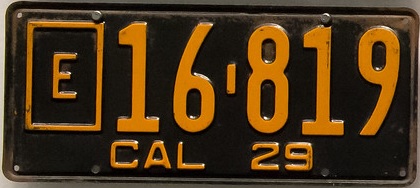
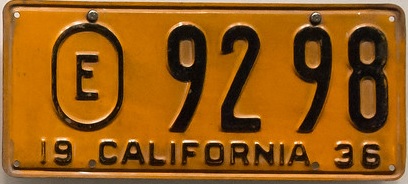
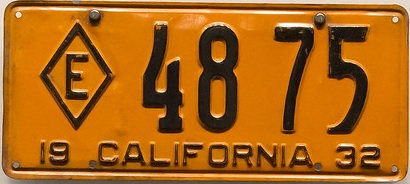
Starting in 1951, however, the distinction between city and county governments was removed. Thenceforth, exempt plates for all local governments had an E in an octagon. (State government plates continued to use the E in a diamond.)
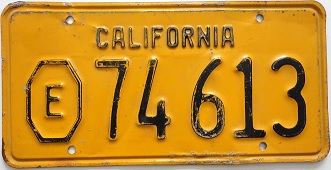
Send comments about this webpage to: rogermw@ix.netcom.com.
Go back to my main license plate index page.
Go back to Roger M. Wilcox's homepage.